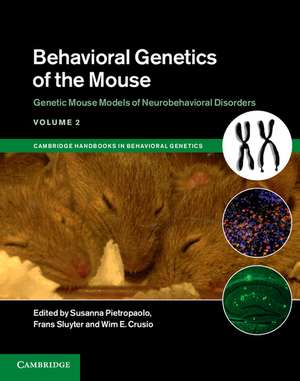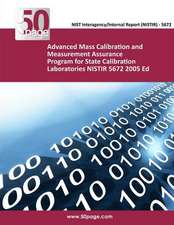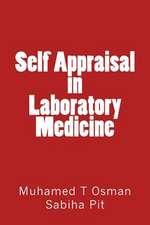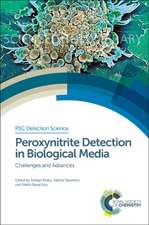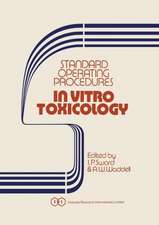Behavioral Genetics of the Mouse: Volume 2, Genetic Mouse Models of Neurobehavioral Disorders: Cambridge Handbooks in Behavioral Genetics
Editat de Susanna Pietropaolo, Frans Sluyter, Wim E. Crusioen Limba Engleză Hardback – 24 sep 2014
Preț: 1040.21 lei
Preț vechi: 1094.96 lei
-5% Nou
Puncte Express: 1560
Preț estimativ în valută:
199.05€ • 208.52$ • 164.96£
199.05€ • 208.52$ • 164.96£
Carte tipărită la comandă
Livrare economică 08-22 aprilie
Preluare comenzi: 021 569.72.76
Specificații
ISBN-13: 9781107044456
ISBN-10: 1107044456
Pagini: 530
Ilustrații: 15 b/w illus. 31 tables
Dimensiuni: 224 x 282 x 25 mm
Greutate: 1.59 kg
Ediția:Revizuită
Editura: Cambridge University Press
Colecția Cambridge University Press
Seria Cambridge Handbooks in Behavioral Genetics
Locul publicării:New York, United States
ISBN-10: 1107044456
Pagini: 530
Ilustrații: 15 b/w illus. 31 tables
Dimensiuni: 224 x 282 x 25 mm
Greutate: 1.59 kg
Ediția:Revizuită
Editura: Cambridge University Press
Colecția Cambridge University Press
Seria Cambridge Handbooks in Behavioral Genetics
Locul publicării:New York, United States
Cuprins
List of contributors; Part I. Introduction to Genetic Mouse Models of Neurobehavioral Disorders: 1. Introduction Frans Sluyter and Wim E. Crusio; 2. Developing mouse models of neurobehavioral disorders: when is a model a good model? F. Josef van der Staay, Saskia Arndt and Rebecca E. Nordquist; Part II. Perception Disorders: 3. Pain disorders Odd-Geir Berge; 4. Disorders of the visual system Stewart Thompson and Alisdair R. Philp; Part III. Autonomous and Motor Disorders: 5. Obesity and anorexia Gertjan van Dijk and Martien J. H. Kas; 6. Sleep disorders Glenda Lassi and Valter Tucci; 7. Cerebellar disorders Robert Lalonde and Catherine Strazielle; 8. Motor disorders David Gordon and Kevin Talbot; 9. Epilepsy Ortrud K. Steinlein; Part IV. Social Dysfunction and Mental Retardation: 10. Pathological aggression Frans Sluyter, Aki Takahashi and Stephen C. Maxson; 11. Disorders of sex Ashlyn Swift-Gallant and Douglas Ashley Monks; 12. Autism Valerie J. Bolivar; 13. Rett syndrome Laura Ricceri, Bianca De Filippis and Giovanni Laviola; 14. Fragile X syndrome Susanna Pietropaolo and E. Subashi; 15. Attention-deficit hyperactivity disorder Tatyana D. Sotnikova and Raul R. Gainetdinov; 16. Obsessive-compulsive disorder and Gilles de la Tourette's syndrome Nancy S. Woehrle and Stephanie C. Dulawa; 17. Schizophrenia Sofya Abazyan and Mikhail V. Pletnikov; 18. Down syndrome Mara Dierssen; 19. Prader–Willi and Angelmann syndromes Emily Y. Smith and James L. Resnick; 20. Williams syndrome Lucy R. Osborne and Zhengping Jia; Part V. Anxiety and Mood Disorders: 21. Anxiety disorders Guy Griebel and Sandra Beeské; 22. Depression Christopher R. Pryce and Federica Klaus; 23. Bipolar disorder Nirit Kara and Haim Einat; Part VI. Substance Dependence and Abuse: 24. Alcohol use disorders John C. Crabbe; 25. Drug abuse: nicotine Rebecca C. Steiner and Marina R. Picciotto; 26. Cannabis abuse and dependence Tim Karl and Jonathon C. Arnold; 27. Drug abuse: amphetamines Tamara J. Phillips, Emily C. Eastwood and John H. Harkness; 28. Cocaine-related disorders F. Scott Hall and Ichiro Sora; 29. Opioids-related disorders Angelo Contarino; Part VII. Neurodegenerative Disorders: 30. Alzheimer's disease Christopher Janus and David Borchelt; 31. Parkinson's disease Iddo Magen and Marie-Françoise Chesselet; 32. Huntington's disease Yoon H. Cho and Susanna Pietropaolo; Index.
Descriere
A comprehensive and critical overview of the major genetically modified mouse lines used to model human neurobehavioral disorders.
